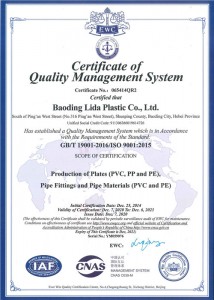நவ் . 11, 2024 08:38 Back to list
pvc-o pipe
Understanding PVC-O Pipes A Comprehensive Overview
Polyvinyl chloride (PVC) has long been a staple material in the construction and plumbing industries. Among its many variants, PVC-O (or oriented PVC) has emerged as a distinguished option due to its remarkable properties and benefits. This article delves into the characteristics, advantages, applications, and sustainability aspects of PVC-O pipes.
What is PVC-O?
PVC-O is a modified form of standard PVC that undergoes an orientation process during its manufacturing. This process involves stretching the material in one or two directions, which aligns the molecular chains, leading to enhanced physical properties. The result is a pipe that boasts improved strength, ductility, and resistance to pressure and impact compared to its non-oriented counterparts.
Key Features of PVC-O Pipes
1. Enhanced Mechanical Strength The orientation process significantly increases the tensile strength of PVC-O pipes. This allows them to withstand higher pressures, making them ideal for water distribution systems and other applications where robustness is crucial.
2. Lightweight and Easy to Handle PVC-O pipes are lighter than many traditional materials, such as steel or concrete. This lightweight nature facilitates easier transportation, handling, and installation, ultimately reducing labor costs and installation time.
3. Superior Flexibility Despite their strength, PVC-O pipes maintain a degree of flexibility. This characteristic is particularly beneficial in applications where ground movement or thermal expansion is a concern, as it reduces the risk of pipe damage.
4. Corrosion Resistance Like standard PVC, PVC-O is resistant to a wide range of chemicals and does not corrode over time. This durability ensures a longer lifespan for the pipes, which often leads to reduced maintenance and replacement costs.
5. Smooth Interior Surface The smoothness of PVC-O pipes reduces friction during fluid flow, resulting in lower energy costs for pumping systems and improved efficiency.
pvc-o pipe

Applications of PVC-O Pipes
PVC-O pipes find their applications in various sectors, including
- Water Distribution Their high strength and durability make PVC-O pipes an excellent choice for potable water transportation and distribution networks.
- Irrigation Systems Farmers and agricultural businesses benefit from using PVC-O pipes for irrigation, as they efficiently deliver water to crops while resisting clogging and wear.
- Wastewater Systems The corrosion-resistant properties of PVC-O make it suitable for carrying sewage and other wastewater, ensuring longevity and reliability.
- Telecommunication and Electricity PVC-O pipes can also be used as conduits for cables and wires, providing protection against environmental elements.
Sustainability of PVC-O Pipes
One of the growing concerns in today's world is sustainability. PVC-O pipes are recognized for their lower environmental impact. The production process is designed to minimize energy consumption, and their longevity translates into reduced waste over time. Moreover, PVC-O pipes are recyclable, contributing to a circular economy by allowing the material to be repurposed at the end of its life cycle.
Conclusion
PVC-O pipes represent a significant advancement in the field of piping solutions. With their unique properties of strength, lightweight construction, flexibility, and chemical resistance, they stand out as a superior choice for various applications. As industries continue to seek sustainable and efficient materials, PVC-O pipes offer a compelling option that balances performance with environmental consciousness. By investing in PVC-O technology, businesses can enhance their operations while contributing positively to the planet.
-
Durable PP Rigid Sheet: Lightweight, Chemical Resistant Solutions
NewsAug.21,2025
-
PVC Grey Sheet for Extraction: Chemical Resistant & Durable
NewsAug.19,2025
-
Durable PVC Pipe Fittings for Plumbing & Irrigation Needs
NewsAug.18,2025
-
HDPE Steel Belt Reinforced Spiral Corrugated Pipe | High Strength
NewsAug.17,2025
-
HDPE Pipe Fittings: Durable, Leak-Proof Solutions
NewsAug.16,2025
-
Premium CPVC Sheet: High-Temp & Chemical Resistant Solutions
NewsAug.15,2025

